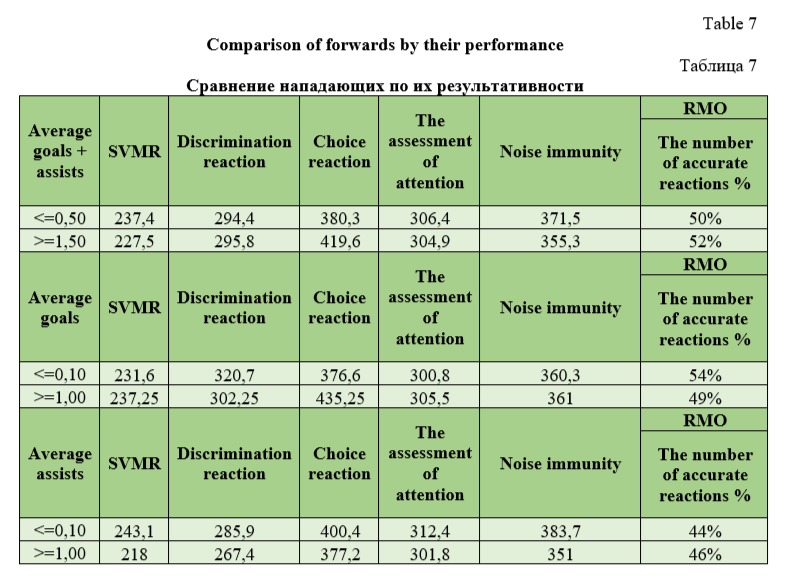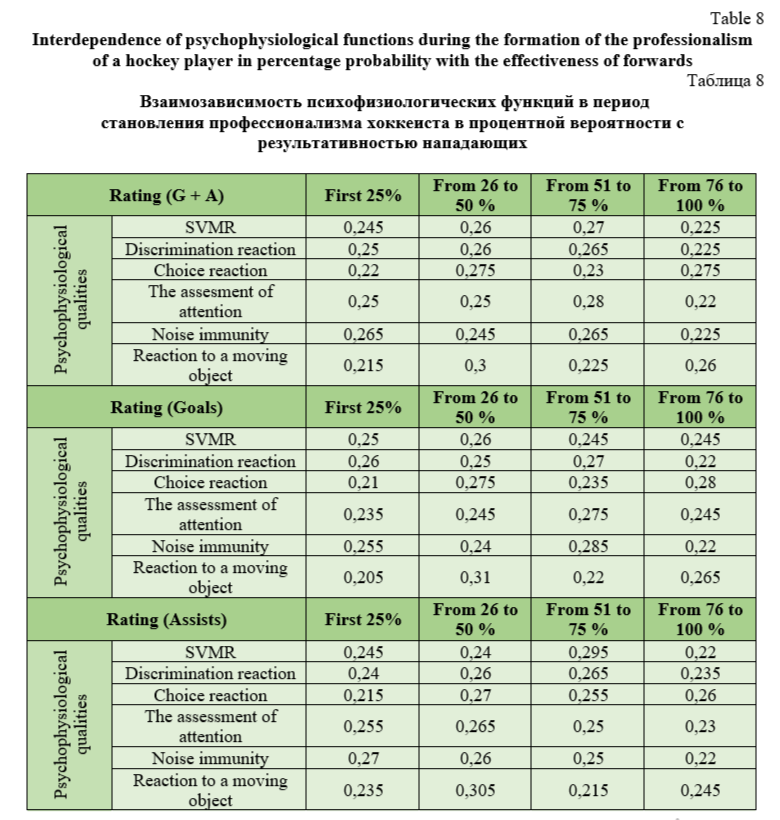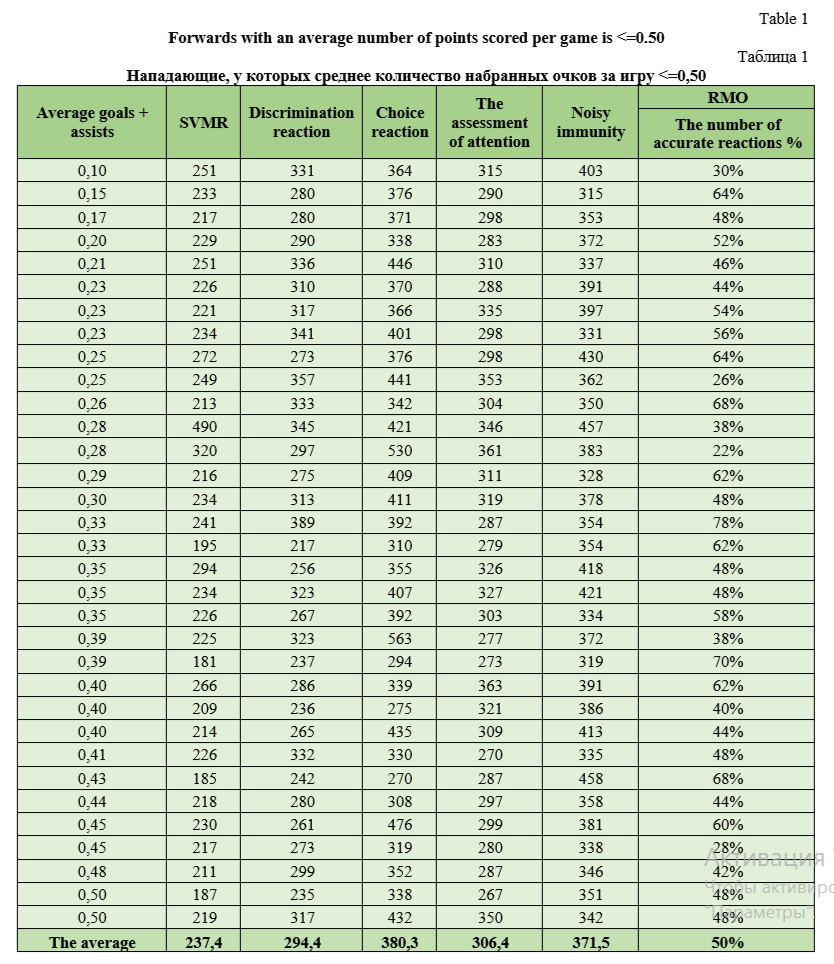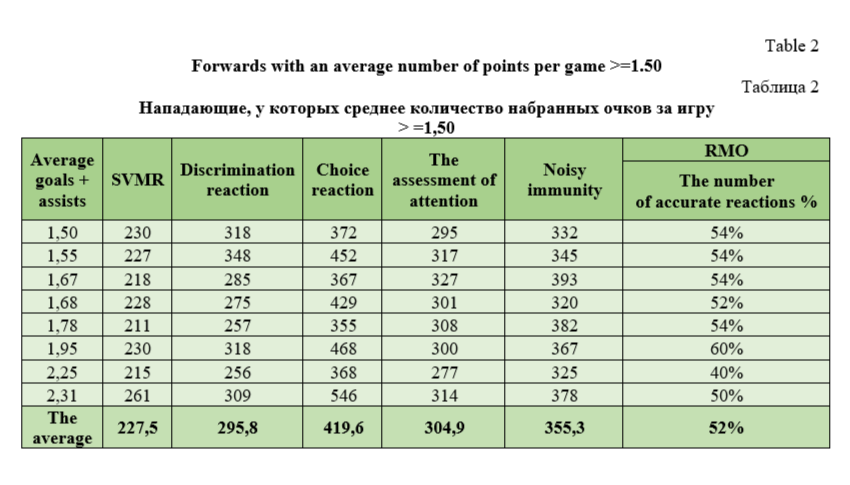Introduction. The Ministry of Sports developed a federal standard that divides children's and youth hockey into the following stages of sports training:
- stage of initial training;
- training stage (stage of sports specialization);
- stage of improvement of sportsmanship;
- stage of higher sportsmanship (Tretyak, Rotenberg, Bure, 2020).
Exactly at the age of 12-14, the stage of sports specialization (training stage) takes place. At this stage coaches need to decide on the professional direction of the players, i.e., the distribution of hockey players by roles, taking into account the psychological and psychophysiological component (Dennis, 2018). The defining characteristic of a highly qualified forward player is his performance, namely the ability to score goals and give assists to his partners (Tarasov, 1988).
V.P. Guba and V.V. Marinich (Guba and Marinich, 2014) considered the concept of selection of children in football and hockey, taking into account physiological indicators of young athletes. A comparison between different sports was also carried out by V.V. Mezentsev in his article “The comparative characteristic of indicators of psychomotility at young hockey players with the ball and the washer in the preparatory period of the year cycle” (Mezentsev, 2017). In this study, we would like to analyze the interdependence of the characteristics of psychophysiological functions with the performance of forwards in hockey.
We should note that an effective forward is one of the roles that a coach can develop in hockey players (Mayorov, 1968). At the stage of higher sportsmanship, coaches can make sports selection for each specific role (Briel, 1980). For example, no coach will make a sports selection of forwards, recruiting players only able to attack, as this will lead to an imbalance in game combinations (Kostka, 1976). In addition, with the selection described above, there will be no forwards capable of performing defensive functions. In this regard, at the stage of sports specialization, coaches lay a certain foundation for the future roles of the forwards, their professional orientation (Smith and Smoll, 2012). It is worth mentioning that there are also different roles for defensemen (Tabrum, 2012).
The issue of the interdependence of psychophysiological characteristics with the performance of forwards in hockey was studied in previous articles where other methods of statistical processing were used (Zapparov, Fukin, 2021, Zapparov, 2022).
The main goal is to analyze the probability of the interdependence of the psychophysiological functions characteristics during the formation of the professionalism of hockey players with the performance of forwards in ice hockey at the age of 12-14. Is there a relationship between effective performance in hockey and the data of testing their psychophysiological qualities? For comparative analysis, we took the average number of goals and assists per game during the competitive season. In addition, for a deeper analysis, we considered each psychophysiological quality separately and compared it with the average number of goals scored and assists made per game. The study examined the following terms that are used in hockey: “score”", “sniper” and “passer”. A “scorer” is the player who scores the most points during the competitive period. A “sniper” is a player who shoots the biggest amount of puck to the opponent’s mesh during the competitive season. A “passer” is a player who makes the most assists to his partners during the competitive season (Hardy, Holman, 2018). The study examines the question of whether there is a relationship between psychophysiological qualities and effective performance in general and separately.
Research hypothesis. The indicators of the speed of a simple visual-motor reaction, the speed of the reaction of discrimination, the speed of the choice reaction, concentration and stability of attention, noise immunity and reaction to a moving object will reveal the ability of forwards to achieve results at the stage of sports specialization in hockey.
The theoretical basis. In the course of the development of hockey players in youth sports, the process of sports selection takes place within the framework of sports training (physical, technical, tactical, theoretical and psychological). During this process, coaches need to determine the roles of the players in the team. In order to achieve high results for 12-14-year-old hockey players, the coach focuses on players who are able to score a large number of points throughout the competition. In this regard, coaches need to determine the starting points and criteria to determine the ability of forwards to score a large number of points.
In modern sports, there is a tendency to develop the speed of movement, the speed of decision-making (Savin, 2003). The primary signal to any external influence is the response of our body (Pocock, Richards C., Richards D., 2017). Moreover, the faster the reaction rate of our body, the more successful we are in a particular sport, where these indicators are important (Muller, 2001). Hockey is no exception. It is extremely important for a hockey player to make quick and effective decisions (Karandin, 1997; Brennan, 2009).
The study considered the question of the interdependence of the characteristics of psychophysiological functions at the stage of sports specialization. The determination of high performance is important for the performance of forwards according to the following criteria:
- the speed of various types of reactions;
- noise immunity;
- attention.
Conducting psychophysiological testing will help to correlate high performance in tests and the performance of hockey forwards in the formation of professionalism at the stage of sports specialization.
Methodology and methods. The method which makes it possible to determine whether there is a statistical difference in psychophysiological qualities between effective forwards with the average points per game >=1.50 (Table 2) and forwards whose average points per game are <=0.50 (Table 1) was considered in the study. The difference of one point is significant here. It plays an important role in the selection. The average number will be found for all statistical indicators. If, however, we evaluate separately the effective actions of goals and assists, then such a difference as 1 point will already be rare and, therefore, the difference will be 0.9. So the average number of goals or assists per game will be >=1.00 (Tables 3, 5) and <=0.10 (Tables 4, 6). Tables 1, 2, 3, 4, 5 and 6 provide information on the following indicators:
- the speed of a simple visual-motor reaction (SVMR);
- speed of discrimination reaction;
- speed of choice reaction;
- assessment of attention;
- noise immunity;
- reaction to a moving object (RMO), namely the number of accurate reactions, the number of advances and the number of delays.
According to the analysis results in the competitive season, 33 forwards have an average performance per game of <=0.50 and 8 forwards an average of >=1.50.

According to the results of the analysis of the competitive season, 10 forwards had an average number of goals scored per game <=0.10 and 4 forwards scored an average of >=1.00.

According to the results of the analysis of the competitive season, 10 forwards had an average number of assists per game <=0.10 and 5 forwards scored an average of >=1.00.

According to the results of the comparison (Table 7), we can say that successful forwards have a better developed simple visual-motor reaction and noise immunity. The discrimination reaction, the reaction to a moving object and attention are on the same level compared to the forwards, whose average performance is <=0.50. It is also necessary to note the fact that the choice reaction is better developed among ineffective players.
Players with the most goals scored against the opponent have a more developed discrimination reaction speed. For all other indicators forwards with the number of goals scored against the opponent's goal is <= 0.10 have an advantage.
The most logical results of the comparative analysis are for forwards who, during the competitive season, completed >=1.00 assists per game on average. For all psycho-physiological qualities the results are on average better than those of the forwards with the average effectiveness of passes <= 0.10.
The psycho-physiological qualities and performance of forwards in hockey were analyzed during the research (Zapparov and Fukin, 2021). It is most important for forwards aged 12-14 to score goals and be able to pass to a goal. In professional hockey, the need for a forward to play productively is very high. The study examined the influence of psychophysiological qualities on abandoned goals and assists, and as a result, it is possible to consider the interdependence of the characteristics of psychophysiological functions during the formation of the professionalism of a hockey player in percentage probability with the performance of forwards. So when dividing the entire list of test forwards in hockey, it is possible to use Table 8. We indicated the percentage of the probability that the list will contain a “scorer”, “sniper” or “passer” for each psychophysiological quality.

Conclusion. Based on the results of the studies of psychophysiological functions, we can say that there is no direct relationship between the performance of forwards in hockey and high performance in tests to determine the speed of a simple visual-motor reaction, discrimination reaction, choice reaction, attention assessment, noise immunity and reaction to a moving object. So, when selecting forwards for hockey teams, these criteria are not entirely accurate to apply if there is a need to choose a high-scoring player.























Reference lists